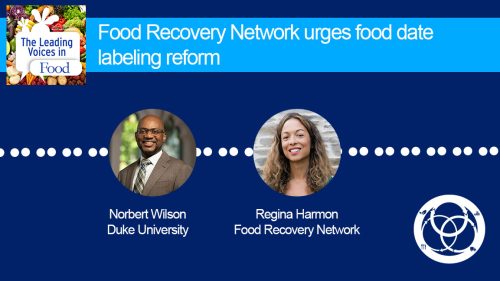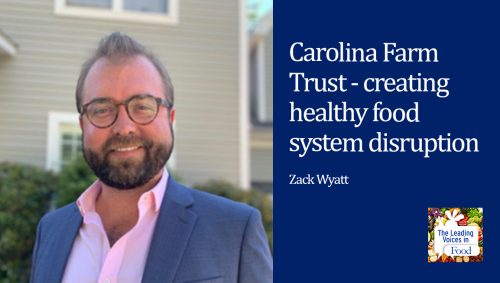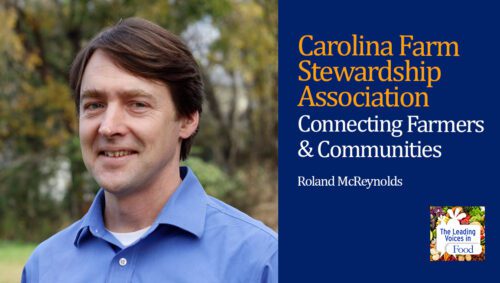The Leading Voices in Food
E52: Hogs and Hurricanes in North Carolina
We’re talking today with Bob Ivey and his daughter, Marlowe Vaughan, owners of Razorback Farms in Goldsboro where they raise pigs as a contractor for Maxwell Farms. Ivey and Vaughan closely follow the news, debates, and lawsuits over pig manure lagoons, odors, and water safety concerns, and they welcomed the opportunity to talk about their own farm operations, and they believe in the value of open communications.
Subscribe: Apple Podcasts | TuneIN | YouTube Music | SoundCloud | PocketCasts | Radio Public
Tags: Agriculture & Tech | Food Waste & Implications | North Carolina | Voice of Farming |

Bob Ivey and his daughter, Marlowe Vaughan are the owners of Razorback Farms in Goldsboro where they raise pigs as a contractor for Maxwell Farms.
Transcript
In North Carolina’s coastal plain, hurricanes and flooding are a part of life as much as country fairs and sweet tea. On the way to Goldsboro, an agricultural town a little more than 50 miles from North Carolina’s capital city of Raleigh, billboards advertise canned boiled peanuts, pork outlet stores and sporting goods. It’s the kind of place where weather conditions are top of mind, and the weather channel plays on a big screen TV at the local Bojangles’ restaurant.
Today I’m talking with Bob Ivey and his daughter, Marlowe Vaughan, owners of Razorback Farms in Goldsboro where they raise pigs as a contractor for Maxwell Foods. Ivey and Vaughn closely follow the news, debates, and lawsuits over pig manure lagoons, odors, and water safety concerns, and they welcomed the opportunity to talk about their own farm operations, and they believe in the value of open communications.
IVEY: One good thing is that now there’s so much technology as far as flood levels and all that. And one of the big things that farmers do when there’s a big storm–is the sites where they can see where the rain is occurring, and what’s happening with the Neuse or the Cape Fear. And they have these monitoring stations up and down the river. Actually I got it [an app] here in my phone. Based on where that flood crests, you can know which roads are going to be flooded, and how it’s going to impact your farm and those type things. The integrator that Marlowe uses actually, in some cases, has moved pigs out, sold them early, in preparation for an event. And I know of two farms that they were worried about and they actually depopulated the farm before the event. Can’t always do that, but you know which farms are or may be a little more risky, based on the weather reports. And I think everybody is very proactive on that.
The other thing is teamwork. And teamwork sometimes just involves the integrator and the contractor, but there’s a lot of teamwork with the state, state veterinarians. They get on the phone and talk with the integrators as far as, “What do you need? Where do you need it? Do you need generators?” If you have a mortality issue, they’re willing to work with you at landfills and stuff to properly dispose of animals if there was something that was to occur.
And usually the integrator is involved in an update, in that discussion. They’re reporting that to these government agencies. And I’ve participated in a lot of those and find it very interesting when people talk about, “Well we’ve had flooding, but no mortality.” And then you hear on the news these elaborate stories about something really bad happening, and it’s just doesn’t match up with the facts that’s been reported. Everybody’s on that call, and so you really need to go and listen to those agencies. They’re well-informed. They’re kept updated, and they participate in trying to find solution for people that’s having problems or are in trouble. So, it takes a lot of teamwork when you have a storm event.
Preparing to mitigate or prevent environmental and public health impacts caused by hurricanes and tropical storm events is a year round collaboration between swine farmers, pork packing and processing companies, veterinarians, and state officials at the North Carolina Department of Environmental and Natural Resources. In North Carolina, hog producers have to have state permits, approved hog manure management plans, and detailed log books that document how many times they fertilize crops using hog manure, adn the results from soil samples to ensure they are not overapplying. Farmers also have to maintain at least one foot between liquid manure and the top fo the lagoon to prevent overflow during storms.
IVEY: One of the big things that Marlowe is doing is she’s preparing for a hurricane. She’s been preparing for that since the spring. And so, there’s times during the year when you can’t pump your lagoon, because there’s no crop growing or those types of things. So that’s heavily regulated. But when she can apply the nutrients from the manure to the fields and the crops, they have a level in the lagoon that it has to be reported to the integrator every week. The lagoon is designed so that it has a 24 hour storm event, on being sure that that’s maintained in case you have a hurricane or those type things. And during the pumping season, she’s actually pumped that lagoon down to the stop pump level. So the farmers here in Eastern North Carolina are very comfortable in managing their lagoons, because we’ve had a lot of hurricanes, and so they’re on top of their games. Getting ready, having that preparedness. Just like any other industry.
In 1999, North Carolina was overwhelmed with rain from Hurricane Floyd and Hurricane Dennis. According to the National Hog Farmer, it was the country’s worst weather disaster in 500 years. At the time, the North Carolina Department of Agriculture estimated 28,000 hogs of all ages had perished in the flood. The memory of that year stays with state regulators and pig farmers who work to minimize the risk of hog deaths and manure lagoon pollution in the future.
VAUGHN: We’ve learned so much since Floyd hit in ’99. It’s going to be the 20 year anniversary this year, in September. So I think it’s really important to understand how far we’ve come as an industry since we learned from that flooding system. We’ve had two farms, and I’m 34 years old now, and in a ’99 I was 14. I don’t think I really… All I really understood about that hurricane system and our farms is that my dad was gone for about a month and I was out of school for a couple of weeks. Now, being a modern farmer and getting so involved with the industry that I am now today, I’ve seen the growth and the transition and what these farmers do to prepare for farms. You know, we’re preparing all year, and during a system, most farmers I know are sleeping on their farms.
You know, when we’re having a flooding system or know that something might be happening, command center where everybody knows what’s going on. We’re bringing in extra feed, we’re getting our farms prepared. It’s not something that we take lightly as farmers, and it’s very important for us, not just for our farms, but for the environment. That’s an important part of the future. I’m not doing this because I’m a fourth generation farmer. I’m doing this for my family, to pass it down to them, so maybe one day I’ll have a fifth generation farmer if they wanted to get involved in the ag industry. I’m doing this for the future, in the future, not only for my family, but for the consumer.
IVEY: The other big thing about some of the farms is that conditions have changed a whole lot. There’s been a bypass built around Goldsboro that blocks the Neuse River flood plain, and it causes some issues. And you can ride from Goldsboro to Raleigh and there’s houses going up everywhere and there’s roads going in, and all that impervious surface creates a lot more flooding. We have to have riparian buffers and those type things on our farm. But really, the urbanization and the growth from Raleigh and the adjacent towns, it has really caused a lot more flooding events when you do have a storm. And so you have to be ready for that too.
And as an industry, typically what we see is not overtopping from the rain, but inundation from this flooding. In fact, the facilities were designed, and then because of all of this urbanization and all this runoff, suddenly farm that 20 years ago we’re perfectly okay, now that they see a impact of waters actually running into the lagoons.
And fortunately, we’ve had some really good programs in North Carolina, and a lot of those farms have participated, worked with the government in those programs. And they have either enhanced their systems, or they have allowed them to be bought out. Like at the last hurricane, you hear a lot about pig mortality, or farmers flooding and all that, and they do flood. But typically it’s the roads, and those type things, and the lagoons get inundated. Very few in the last storm actually overtopped. I think it’s just a handful. And a lot of the ones that are in these sensitive areas now are looking at on moving those farms, and working with the government to have a buyout.
Unfortunately, North Carolina has a moratorium, and we haven’t been permitted to build a farm since 1996. That’s when the moratorium started. So I find it very funny and very interesting that people, attack our industry in North Carolina when we haven’t really been able to do anything but rebuild or improve the facilities on the sites that have been permitted because of this moratorium. Which is unfortunate, because a lot of people would probably move their farms as conditions change, if they were allowed to. And so it really interferes with, in my opinion, some good management practices that people could take advantage of in moving a farm, based on towns and cities growing up close to the farm.
A lot of the farms that the integrators have built, in fact, I’ve participated in a lot of the site work and those type things. When we built the farms, we can show you photos and there was not a house around that farm, no houses around that farm. And then we can show today, where people were build their homes right up to the spray fields. In this county, in Wayne County, there’s a setback that you can’t build a hog house within 1500 feet of a residence. Well, in Wayne County, they have had the reverse of that, that you can’t build a residence within 1500 feet of a hog house. So I find it interesting that people would talk about how bad it is, but that if that were true, people wouldn’t be building three and four hundred thousand dollar homes right up to the property lines of a farm.
And so, I think that that’s a lot of misconceptions as far as North Carolina permitting them more hog farms, and when they do something on the farm, they are allowed to update it and modernize. And, if it’s in a sensitive area, got programs so that we can move out of that area. So good story to tell, again that’s seldom told.











